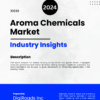Aroma Chemicals Market Overview:
The Aroma Chemicals Market was valued at USD 6.16 billion in 2024 and is projected to exceed USD 11.37 billion by 2034, at a CAGR of 6.6%.
The aroma chemicals market encompasses a wide range of synthetic and natural compounds used to impart fragrance to various consumer and industrial products. These chemicals are essential ingredients in perfumes, cosmetics, toiletries, household cleaners, and food and beverage products. Key drivers of the aroma chemicals market include the growing demand for scented personal care and homecare products, changing consumer preferences for natural and sustainable fragrances, and increasing disposable incomes in emerging economies. The market is characterized by a diverse portfolio of aroma chemicals, including alcohols, esters, ketones, and terpenes, each offering unique scent profiles and functional properties. Technological advancements in fragrance creation, extraction, and synthesis drive product innovation and market competitiveness. Additionally, regulatory compliance, safety standards, and sustainability considerations influence market dynamics and product development strategies. Geographically, Asia-Pacific is a significant market for aroma chemicals, driven by the expanding cosmetics and personal care industry in countries like China, India, and Japan. Overall, the aroma chemicals market is poised for steady growth, fueled by evolving consumer preferences, product innovation, and expanding applications across various industries.
Aroma Chemicals Market- Report Coverage:
The “Aroma Chemicals Market Report – Forecast (2024-2034)” by Digiroads Consulting, covers an in-depth analysis of the following segments in the Aroma Chemicals Market Market.
| Attribute | Segment |
| By chemical Type |
|
| By Aroma Nodes |
|
| By Application |
|
| By Product Type |
|
| By Location |
|
Aroma Chemicals Recent Developments :
- Focus on Natural & Sustainable Ingredients: Consumers are increasingly drawn to natural and sustainable fragrances. This has led companies to invest in developing aroma chemicals derived from botanical sources or using eco-friendly production processes .
- Expansion in Asia Pacific: The Asia Pacific region is witnessing significant growth in the aroma chemicals market, driven by factors like rising disposable income and a booming cosmetics industry .
- Mergers & Acquisitions: The market has seen some consolidation activity. For instance, S H Kelkar and Company acquired PFW Aroma Ingredients B.V. to strengthen its aroma chemicals business .
- Product Innovation: Companies are actively developing new aroma chemicals to cater to evolving consumer preferences. For example, Solvay enhanced its flagship Rhovanil Natural product line with new natural flavors in September 2022 .
To stay updated on the latest developments, you can explore these resources:
- Industry reports by Mordor Intelligence or Fortune Business Insights provide market analysis and recent news .
- Company press releases from major players like Solvay or Kao Corporation might announce new product launches or strategic initiatives.
- Industry publications or trade shows focused on flavors and fragrances can also be good sources of information.
Aroma Chemicals Market- Dynamics:
The aroma chemicals market dynamics are influenced by several key factors:
- Changing Consumer Preferences: Evolving consumer preferences for natural, sustainable, and unique fragrances drive innovation in the market. Demand for exotic and niche scents influences product development and market trends.
- Growing Demand in End-Use Industries: The aroma chemicals market is closely tied to industries such as cosmetics, personal care, homecare, and food and beverages. Growth in these sectors, driven by increasing urbanization, rising disposable incomes, and changing lifestyles, boosts demand for fragrance ingredients.
- Technological Advancements: Continuous advancements in fragrance creation, extraction, and synthesis technologies enhance the efficiency and efficacy of aroma chemicals production. Innovative techniques enable the development of new scent profiles and improve product quality.
- Regulatory Compliance: Compliance with regulations and safety standards governing the use of aroma chemicals is essential for market players. Adherence to regulatory requirements ensures product safety, consumer trust, and market access.
- Sustainability Initiatives: Rising awareness of environmental sustainability and eco-friendly practices drives demand for natural and sustainable aroma chemicals. Manufacturers are increasingly focusing on green chemistry, renewable resources, and biodegradable ingredients to meet consumer preferences and regulatory mandates.
- Market Competition: Intense competition among key players in the aroma chemicals market drives innovation, product differentiation, and strategic partnerships. Companies invest in research and development to introduce novel fragrance ingredients and gain a competitive edge in the market.
- Global Trade Dynamics: International trade agreements, tariffs, and trade barriers impact the flow of aroma chemicals across borders, influencing market supply, pricing, and competitiveness. Geopolitical factors and trade policies shape market dynamics and trade relationships between countries.
- Consumer Trends and Marketing Strategies: Understanding consumer trends, preferences, and purchasing behaviors is crucial for market players. Effective marketing strategies, branding, and product positioning influence consumer perceptions and drive product adoption in the aroma chemicals market.
Overall, the aroma chemicals market dynamics are characterized by changing consumer preferences, growing demand in end-use industries, technological advancements, regulatory compliance, sustainability initiatives, market competition, global trade dynamics, and consumer trends. Adapting to these dynamics is essential for stakeholders to capitalize on opportunities and address challenges effectively in the market.
Key Market Players:
Product/Service launches, approvals, patents and events, acquisitions, partnerships and collaborations are key strategies adopted by players in the Market. The top 10 companies in this industry are listed below:
- Givaudan
- Firmenich
- International Flavors & Fragrances Inc. (IFF)
- Symrise
- Takasago International Corporation
- Sensient Technologies Corporation
- Mane SA
- Robertet Group
- T. Hasegawa Co., Ltd.
- Bell Flavors & Fragrances
Key Benefits For Stakeholders:
Product Differentiation: Aroma chemicals allow manufacturers to differentiate their products by offering a wide range of scents and fragrances tailored to consumer preferences. This differentiation helps companies stand out in a competitive market and build brand recognition.
Market Growth Opportunities: The growing demand for aroma chemicals in industries such as cosmetics, personal care, homecare, and food and beverages presents significant growth opportunities for stakeholders. Expansion of these sectors, driven by factors like urbanization and changing consumer lifestyles, fuels market growth.
Revenue Generation: Aroma chemicals contribute to revenue generation for manufacturers, suppliers, and distributors across the supply chain. As essential ingredients in fragrance formulations, aroma chemicals command a market value that translates into revenue streams for stakeholders.
Innovation and Product Development: Stakeholders benefit from continuous innovation in aroma chemicals, including the development of new scent profiles, extraction techniques, and sustainable ingredients. Innovation drives product development and market competitiveness, allowing companies to meet evolving consumer demands.
Customer Satisfaction: Offering high-quality aroma chemicals enables manufacturers to create fragrances that meet consumer expectations for scent, longevity, and performance. Customer satisfaction leads to brand loyalty and repeat purchases, enhancing stakeholder profitability and market share.
Regulatory Compliance: Adhering to regulatory standards and safety guidelines ensures product quality, consumer safety, and market access. Stakeholders benefit from compliance with regulations governing aroma chemicals, enhancing their reputation and credibility in the market.
Sustainability Initiatives: Stakeholders can capitalize on the growing demand for natural and sustainable fragrance ingredients by offering eco-friendly aroma chemicals derived from renewable resources. Sustainability initiatives appeal to environmentally conscious consumers and support corporate social responsibility goals.
Global Market Reach: Access to international markets through trade agreements, distribution networks, and strategic partnerships enables stakeholders to leverage global demand for aroma chemicals. Expanding market reach increases sales opportunities and revenue potential for stakeholders.
We have studied the Aroma Chemicals Market Marketin 360 degrees via. both primary & secondary research methodologies. This helped us in building an understanding of the current market dynamics, supply-demand gap, pricing trends, product preferences, consumer patterns & so on. The findings were further validated through primary research with industry experts & opinion leaders across countries. The data is further compiled & validated through various market estimation & data validation methodologies. Further, we also have our in-house data forecasting model to predict market growth up to 2034.
Contact us for any inquiry.
Table of Contents
- INTRODUCTION
1.1 Study Assumptions & Market Definition
1.2 Scope of the Study
- RESEARCH METHODOLOGY
- EXECUTIVE SUMMARY
- MARKET DYNAMICS
4.1 Market Overview
4.2 Market Drivers
4.3 Market Restraints
4.4 Porter’s Five Forces Analysis
4.4.1 Bargaining Power of Suppliers
4.4.2 Bargaining Power of Buyers
4.4.3 Threat of New Entrants
4.4.4 Threat of Substitute Products
4.4.5 Intensity of Competitive Rivalry
- MARKET SEGMENTATION
- Aroma Chemicals Market– By chemicals Type
- Aldehydes
- Ketones
- Esters
- Alcohols
- Terpenes
- Lactones
- Phenols
- By Aroma Nodes
- Floral
- Fruity
- Citrus
- Woody
- Herbal
- Spicy
- Sweet
- Minty
- Earthy
- By Application
- Cosmetics
- Personal Care Products
- Fine Fragrances
- Household Cleaners
- By Product Type:
- Essential Oils
- Synthetic Aroma Chemicals
- Natural Aroma Chemicals
- Aroma Blends
- Extracts
- By Location:
- Grasse, France
- Geneva, Switzerland
- Mumbai, India
- Singapore
- New Jersey, United States
- COMPETITIVE LANDSCAPE
6.1 Most Adopted Strategies
6.2 Market Share Analysis
6.3 Company Profiles
- Givaudan
- Firmenich
- International Flavors & Fragrances Inc. (IFF)
- Symrise
- Takasago International Corporation
- Sensient Technologies Corporation
- Mane SA
- Robertet Group
- T. Hasegawa Co., Ltd.
- Bell Flavors & Fragrances
- MARKET OPPORTUNITIES AND FUTURE TRENDS


